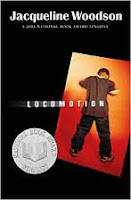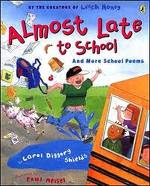
Woodson, Jacqueline. 2003. LOCOMOTION. New York: G.P. Putnam’s Sons. ISBN 0399231153 [Suggested Grade Levels 4-7]
SUMMARY and ANALYSIS
In a foster home and separated from his sister, Lonnie Collins Motion discovers the power of poetry through an understanding teacher who urges him to write down his thoughts and feelings as fast as they come. As he works through the various assignments of different kinds of poems, Lonnie gradually reveals the source of all his anguish. His parents’ deaths, the separation from his sister, and the desire to once again be a part of a family provide a wealth of inspiration for Lonnie’s emerging talent as a poet. As the story progresses, the poetry transforms from simply an outpouring of overwhelming emotion to carefully crafted works of self-expression.
Using both free verse and formal poetry, Woodson develops a story not soon to be forgotten. By addressing the poetry directly through Lonnie’s assignments, the reader learns and begins to appreciate along with him. The secondary characters develop to just the right degree to validate their importance in Lonnie’s life, but do not distract from the intensity of his revelations. Lonnie’s poetry is both heartbreaking and endearing, leaving the reader hoping desperately that everything will work out in the end.
CONNECTIONS
Recommend this book to students who are struggling, due to lack of interest, to complete required poetry assignments. Point it out as an excellent example of non-stereotypical free verse and formal forms of poetry that might surprise a reluctant reader.
For children dealing with grief or anger issues, this book makes an “easy-to-relate-to” choice. Encourage them to follow Lonnie’s example by writing and getting their feelings out.
RELATED BOOKS
Other poetry books about expressing feelings:
Grimes, Nikki. BRONX MASQUERADE. ISBN 0803725698
Smith, Hope Anita. THE WAY A DOOR CLOSES. ISBN 080506477X
WritersCorps. PAINT ME LIKE I AM. ISBN 0064472647
Other books by Jacqueline Woodson:
HUSH. ISBN 0399231145
LAST SUMMER WITH MAIZON. ISBN 0399237550
MIRACLE’S BOYS. ISBN 0399231137
By Amy D. Picard
































